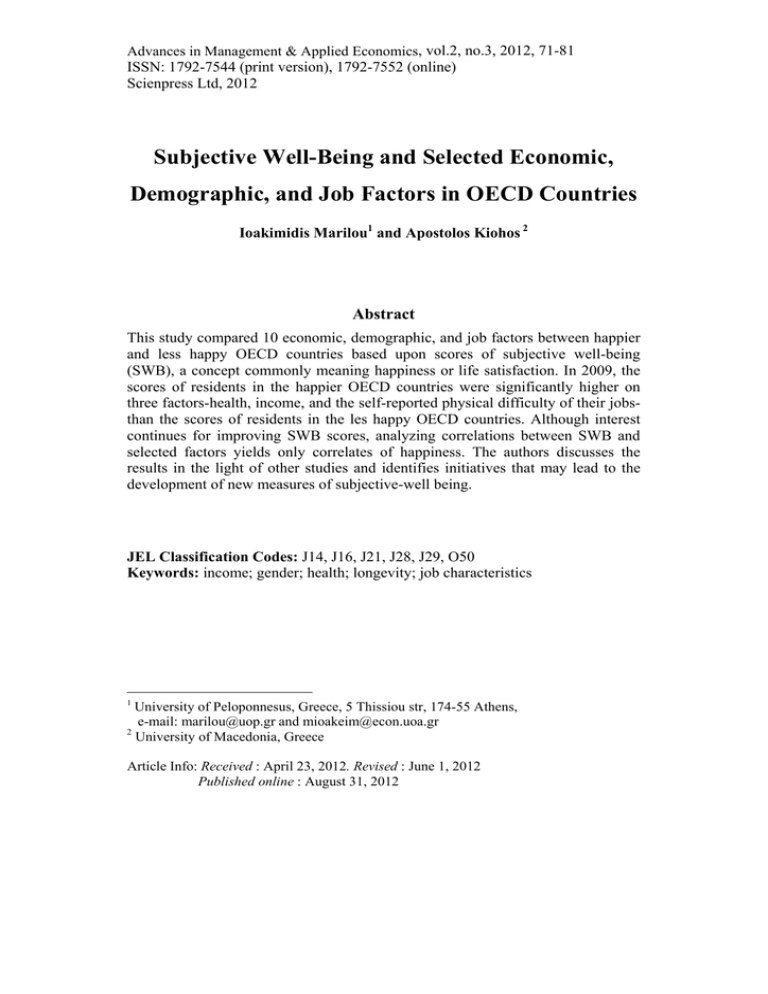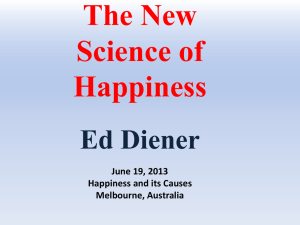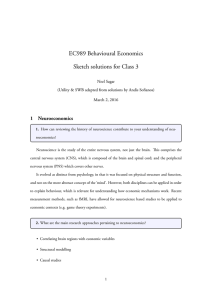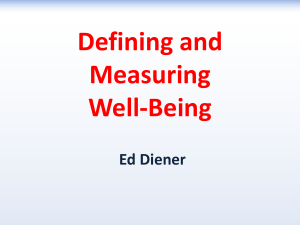Subjective Well-Being and Selected Economic, Abstract
advertisement

Advances in Management & Applied Economics, vol.2, no.3, 2012, 71-81 ISSN: 1792-7544 (print version), 1792-7552 (online) Scienpress Ltd, 2012 Subjective Well-Being and Selected Economic, Demographic, and Job Factors in OECD Countries Ioakimidis Marilou1 and Apostolos Kiohos 2 Abstract This study compared 10 economic, demographic, and job factors between happier and less happy OECD countries based upon scores of subjective well-being (SWB), a concept commonly meaning happiness or life satisfaction. In 2009, the scores of residents in the happier OECD countries were significantly higher on three factors-health, income, and the self-reported physical difficulty of their jobsthan the scores of residents in the les happy OECD countries. Although interest continues for improving SWB scores, analyzing correlations between SWB and selected factors yields only correlates of happiness. The authors discusses the results in the light of other studies and identifies initiatives that may lead to the development of new measures of subjective-well being. JEL Classification Codes: J14, J16, J21, J28, J29, O50 Keywords: income; gender; health; longevity; job characteristics 1 University of Peloponnesus, Greece, 5 Thissiou str, 174-55 Athens, e-mail: marilou@uop.gr and mioakeim@econ.uoa.gr 2 University of Macedonia, Greece Article Info: Received : April 23, 2012. Revised : June 1, 2012 Published online : August 31, 2012 72 Subjective Well-Being and Selected Economic, Demographic, and Job Factors 1 Background Interest by philosophers, economists, and politicians in subjective wellbeing, often colloquially called happiness, has a long history (White, 2007). Over 2,000 years ago, in the Nicomachean Ethics, the Greek philosopher Aristotle outlined principles for leading a happy life (Parry, 2009). By the late 18th century, the United States Declaration of Independence identified happiness, along with life and liberty, as an inalienable right of all citizens. More recently, psychologists have endorsed the implementation of government policies that facilitate subjective well-being and have endorsed measures of subjective well-being as tools for evaluating a society (Diener, 2000; Diener and Suh, 1997). Subjective well-being (SWB) has usually been measured by asking persons a simple question such as, “How happy are you with your life these days?” or “All in all, are you very happy, happy, or not happy?” (Krueger and Schkade, 2008). Researchers have associated SWB, or life satisfaction, with a wide scope of factors. These include age (Rojas, 2007), affect (Fordyce, 1977), education (Glenn and Weaver, 1981), GDP (Inglehart, 1999), gender (Toseland and Rasch, 1979-1980), health (Cohen, Doyle, Turner, Alper, and Skoner, 2003), income (Diener and Biswas-Diener, 2002), race (Sauer, 1977), employment status (Campbell, Converse, and Rodgers, 1976), and self-esteem (Diener, 2009). Diener and Chan (2011), having assessed the SWB of more than 13,000 persons in 31 countries, reported that approximately two-thirds of men and women recorded a positive score on measures of life satisfaction. Thus, Tov and Diener (2009) pointed out that humans as a whole are happy, at least to some extent, with the SWB of most countries falling above the midpoint of the scale being used to measure SWB. They urged future researchers to try to determine what factors account for the circumstance when the members of a society score below the midpoint on a measure of SWB. The relation of SWB to a country’s economic development and the income of its citizens has been a matter of controversy. In cross-country comparisons, Easterlin (1974) found that SWB does not vary a great deal with national average income per person as long as citizens’ basic needs are being met. Furthermore, while average income rose in the United States between 1960 and 1970, selfreported SWB declined. Easterlin suggested that where income and SWB are found to be associated within a society, this may be partly attributable to dissatisfaction caused by individuals with lower incomes comparing their incomes to those of fellow citizens with higher incomes. Oswald (2006) supports the view that beyond a certain minimum level, addition to individual wealth does not result in a large increase in reported SWB. This is not to say that some economic or jobrelated circumstances do not have a substantive impact on happiness, for according to Blanchflower and Oswald (2002), the condition of being unemployed has a significant negative effect on life satisfaction. Research by Stevenson and Wolfers (2008) calls into question the findings of Easterlin (1974). The researchers re-examined results from studies of SWB Ioakimidis Marilou and Apostolos Kiohos 73 collected from multiple large-scale surveys and cross-country datasets. Assessing “the relationship across countries between well-being and the log of GDP per capita” (p. 3), these researchers linked the happiness of a society, rich or poor, with economic growth and development. According to Stevenson and Wolfers, scores of SWB are higher among members of richer societies, and scores are higher among richer members of a society than those of its poorer members. Using data from the Gallup World Poll, Deaton (2008) found a correlation exceeding 0.8 between measures of subjective well-being and the log of GDP per capita. In short, increasing incomes was linked to increasing happiness: “Subjective wellbeing-income . . . is not only significant but also remarkably robust across countries, within countries, and over time” (p. 3). A main approach to investigating SWB has been to compare particular economic and social factors to measures of happiness or life satisfaction among countries. In this study, the researcher compared differences of 10 health, economic, and job-related factors between countries belonging to the Organisation for Economic Co-operation and Development (OECD) that were lower and higher in their citizens’ self-reported SWB (OECD, 2009). Headquartered in Paris, the OECD consists of 34 democratic countries, describing itself as committed to sustaining economic growth, increasing employment and standards of living, maintaining financial stability, collaborating to achieve economic development, and increasing world trade (OECD, 2010). OECD members meet regularly to compare activities and policies, address common concerns, and share effective practices. Members of the OECD were chosen for this study for several reasons. First, despite numerous considerable differences among the OECD’s members, they form a unitary group in which all member nations can be considered basically democratic, thereby reducing the possible influence of type of government (in particular, autocratic vs. nonautocratic) on SWB. Second, the standard of living of member nations is such that for the most part, the basic needs of its citizens are cared for. Thus, according to Easterlin (1974) and Blanchflower and Oswald (2002), average income should not play a large role in determining differences in cross-country SWB. Third, according to the SWB measure and SWB data used (Marks, Abdallah, Simms, and Thompson, 2006), there is a relatively wide range of self-reported life satisfaction in the OECD nations (177 to 273). Given this range of SWB scores, the objective of the study was to determine whether there were any significant differences between the OECD countries with lower SWB scores and those with higher scores in respect to their relation to health, economic, and employment indicators. 74 Subjective Well-Being and Selected Economic, Demographic, and Job Factors 2 Procedures In this study, scores of SWB were used to define two groups: the 15 OECD countries with the highest SWB scores and the 15 with the lowest SWB scores. Scores of only 30 OECD nations were used because these 30 countries were the only OECD members at the time of the study by Marks et al. (2006). These SWB scores, from lowest to highest, are shown in Table 1. Table 1: Subjective Well-being for 30 OECD Nations __________________________________________________________________ Nation Subjective Well-being _________________________________________________________________ Fifteen OECD countries with the lowest SWB scores (177–240) Turkey Slovak Republic Poland Hungary Korea Portugal Japan Greece Czech Republic France Italy Mexico Spain United Kingdom Germany 177 180 187 190 193 203 207 210 213 220 230 230 233 237 240 Fifteen OECD countries with the highest SWB scores (243–273) Australia Belgium New Zealand Norway United States Netherlands Canada Ireland Luxembourg Finland Sweden 243 243 247 247 247 250 253 253 253 257 257 Ioakimidis Marilou and Apostolos Kiohos 75 Austria 260 Iceland 260 Denmark 273 Switzerland 273 __________________________________________________________________ Ten countries for which sufficient data were available to perform the analysis were selected from each of these two sets of OECD countries. From the 15 lowest scoring OECD countries, these were the following: Hungary, Korea, Portugal, Japan, the Czech Republic, France, Mexico, Spain, the United Kingdom, and Germany. From the 15 OECD countries scoring highest on SWB, the following 10 had sufficient data for the analysis: Belgium, New Zealand, Norway, United States, Canada, Ireland, Finland, Sweden, Austria, and Denmark. Ten health, economic, and job-related factors were chosen to be compared between the two sets of countries. These factors were, men’s longevity, women’s longevity, overall health, national unemployment rate, and workers’ perceptions of six characteristics of their current employment: income, job security, opportunities for advancement, stressful working conditions, to what degree the job required hard physical work, and degree of coming home from work exhausted. These 10 indicators were chosen as representative of a range of potentially important factors that might be associated with the SWB measures. Data for all 10 measures were gathered from the OECD’s publication Society at a Glance 2009: OECD Social Indicators. 3 Results Overall, the mean SWB score of the sample (235.8) approximated the mean of the 30 OECD countries (232.2). Life expectancy scores of the sample (men = 76.01, women = 81.72) were nearly identical to the corresponding SWB means of all OECD countries (men = 76, women = 81.7). No paired difference was statistically significant at the 0.05 level of confidence. Table 2 presents descriptive statistics for SWB in longevity and health in the 10 countries with the higher SWB scores and the 10 with the lower scores. Table 3 displays ranks and test statistics for longevity and health using the MannWhitney U. A statistically significant difference was found for health (p = 0.001) but not for longevity (men: p = 0.052, women: p = 0.427) between the happier and less happy OECD countries. Table 4 presents the ranks and test statistics using the Mann-Whitney U for unemployment and six job-related factors. A statistically significant difference was found for income (p = 0.005) and respondents’ perceptions of hard physical work in their current job (p = 0.019) between the happier and less happy OECD countries. 76 Subjective Well-Being and Selected Economic, Demographic, and Job Factors Table 2: Descriptive Statistics for Longevity and Health SWB Higher Lower Combined Life Expectancy Men Women Combined Health n Mean Std Dev Min Max 10 10 20 255.800 216.600 232.200 10.541 18.192 235.800 243 190 190 273 240 273 10 10 20 20 76.390 82.025 78.853 70.000 2.366 2.048 2.326 16.248 69.00 77.40 73.20 39.00 79.00 85.80 82.40 90.00 Table 3: Ranks and Test Statistics for Longevity and Health SWB Group Longevity men Longevity women Health a Higher Lower Higher Lower Higher Lower n Mean Rank Sum of Ranks 10 10 10 10 10 10 13.05 7.95 11.55 9.45 15.00 6.00 130.50 79.50 115.50 94.50 150.00 60.00 MannWhitney U 0.052a 0.436a 0.001a Not corrected for ties. Table 4: Ranks and Test Statistics for Job Factors Job security High income Advancement Exhausting Hard Stressful Unemployment a SWB Group Higher Lower Higher Lower Higher Lower Higher Lower Higher Lower Higher Lower Higher Lower Not corrected for ties. n 10 10 10 10 10 10 10 10 10 10 10 10 10 10 Mean Rank 12.55 8.45 14.10 6.90 11.80 9.20 9.40 11.60 7.40 13.60 11.95 9.05 8.80 12.20 Sum of Ranks 125.5 84.5 141.0 69.0 118.0 92.0 94.0 116.0 74.0 136.0 119.5 90.5 88.0 122.0 MannWhitney U 0.123a 0.005a 0.353a 0.436 a 0.019 a 0.280 a 0.218 a Ioakimidis Marilou and Apostolos Kiohos 77 4 Discussion and Conclusions The analysis provided several notable results. The first of these was the difference in the health of citizens of the two sets of nations (significant at the .001 level). Health and SWB have previously been found to be positively related (Diener and Chan, 2011), as it was in this study. It of course cannot be determined whether these results are indicative of good health tending to increase happiness, or higher degrees of happiness having health benefits to individuals. It may be that these two variables are mutually supporting, as it is generally assumed that one’s health affects one’s happiness and it is claimed by Diener and Chan (2011) that there are health benefits that accrue from increases in life satisfaction. It is evident that more research is needed to tease out just what are the relationships between SWB and health. A second interesting result of the findings is that income was significantly lower in the countries with lower SWB, suggesting that income is a positive correlate of happiness. As previously noted, Stevenson and Wolfers (2008), appear to hold this view, while others (Easterlin, 1974; Blanchflower and Oswald, 2002) claim that in cross-country analyses, income above the level of being able to take care of basic needs has only a mild correlation with life satisfaction. The results of the present analysis support the Stevenson and Wolfers research. It should also be noted that Easterlin’s research was published almost 40 years ago, and that during the ensuing years, the phenomenon of globalization and worldwide instantaneous communication may have led citizens in many countries to be more aware of incomes in other countries. If so, the kind of dissatisfaction thought by Easterlin to possibly affect lower income individuals when they compare their incomes to those of higher income individuals in-country, may now be taking place between countries. That is, individuals in lower average income countries may become dissatisfied when they compare their own incomes to higher average income countries, a comparison made possible through knowledge gained about other countries through communication media such as the Internet. Again, further research is needed in this area to better understand both the in-country and crosscountry relation of income to happiness in today’s increasingly globalized world. Another notable result of the findings was that though the difference in men’s longevity between the two sets of countries did not reach statistical significance, it almost did, whereas the difference in women’s longevity did not approach statistical significance. This finding suggests that there is a possible difference between men and women in how degree of life satisfaction is related to their longevity. Unfortunately, the health variable was not broken out into men’s and women’s health, since it is possible that doing so would have shown a difference between the two genders in how SWB was related to their health. Further research is needed to determine if there are indeed differences between genders in how SWB relates to both longevity and health. A fourth notable finding was a significant difference between the lower and higher SWB countries in respect to citizens’ perceptions of their work at their 78 Subjective Well-Being and Selected Economic, Demographic, and Job Factors current job being physically hard. This finding suggests that SWB tends to decrease with the physical difficulty of citizens’ employment. If so, this may be partly due to workers’ comparing their lot with others in their society that do not have to work so physically hard. This possibility calls for research to determine if it is the difficulty of their work itself or their comparisons of their working tasks to easier ones had by others that has an apparent dampening effect on the SWB of workers who perceive their work to be physically hard. One further notable result of the findings is that unemployment had no significant association with SWB when the two groups were compared. This finding appears to be in opposition to Campbell, Converse, and Rodgers’ (1976) finding of an association between life satisfaction and employment status. Furthermore, Blanchflower and Oswald (2002) found unemployment status significantly associated with lower SWB. Why unemployment was not found to be associated with SWB in this study is unclear. However, it should be noted that this study’s analysis was not a direct comparison of individuals’ SWB scores with their unemployment status. The findings suggest that there may be economic or societal factors that affect the overall unemployment rate of a nation without affecting citizens’ SWB. Overall, this study’s results supported some previous findings, though a much greater difference was found between SWB and longevity among men than among women than was found previously, and no association between SWB and unemployment status was found. Regarding the employment measures explored, the relationship between SWB and two factors, income and hard work, differed significantly between OECD countries that recorded the highest and lowest SWB scores. Job satisfaction can be expected to be related to life satisfaction, and researchers have found significant positive relationships between SWB and scores of health and job satisfaction. The majority of adults in OECD countries expressed satisfaction with their work hours and salaries (OECD, 2009), although a substantial number of persons wanted to work more hours to earn additional income, particularly in France and Mexico. Many studies other than this one have analyzed possible correlations between SWB and selected demographic, economic, and employment factors. A major limitation of this approach is that outcomes generally yield only correlates of happiness, and deeper understandings about the predictors of happiness are needed. Though worldwide, two-thirds of humans tested have recorded positive scores on measures of happiness or life satisfaction (Diener and Chan, 2011), there are marked differences between countries as exhibited in this research. Accordingly, there is continued interest in understanding the factors that predict lower scores and interest in improving scores overall and within countries (Tov and Diener, 2009). This is perhaps related to the idea that a principal goal of government should be to create happiness. A survey conducted in the United Kingdom (Easton, 2006) found that this belief was held by the vast majority of respondents. Ioakimidis Marilou and Apostolos Kiohos 79 A different research basis for understanding human societies and, by extension, life satisfaction was implicitly identified by Smith (2006), who pointed to language and social aspects of culture as principal sources of differences among societies—sources or influences that he argues result from chance: “Who we are depends on the other persons we know throughout our lives, where we live, health, wealth, social status, education, television, books, music, films, technology, and language. .” (p. viii). Smith argues that the basis of language and learning is social: “We see (or read about) other people, and assume that we’re like them. . . . We don’t learn what we’re like from looking inside ourselves, but from looking at other people” (p. 8). This view suggests that subjective well-being may be learned and linked to cultural factors. If so, new insights about SWB may require that future research consider more fully what cultural factors may be associated with life satisfaction. A different kind of initiative for exploring the nature of SWB was put forward by Kahneman and Krueger (2006), who pointed out that to measure individuals’ life satisfaction typically requires them to make a brief global retrospective judgment, which may be influenced by their mood and memory at that moment. Contextual factors, too, such as the current weather, whether dreary or sunny, may affect responses. They suggest measuring individuals’ evaluations of the satisfactoriness of their recent experiences, with those evaluations being collected real-time or by way of diary entries, as an alternative way of measuring SWB that has the advantages of minimizing the effects of the filter of memory and being tied to how people actually spend their time. They further suggest developing a U-index that measures what proportion of their time individuals spend in what they judge to be an unpleasant emotional state. Such an index, they claim, would be well suited for making cross-country comparisons that minimize the effects of language and cultural differences. Smith’s (2006) and Kahneman and Krueger’s (2006) viewpoints make even clearer what is already evident, that investigations of subjective well being— happiness—are only in their infancy. New ways of measuring this central phenomenon of people’s lives are being developed. This is not to say that measuring SWB by simply asking individuals how they currently feel about their lives as a global evaluation will not continue to be important. Many extraneous variables that may affect such evaluations can be expected to cancel one another out. An additional task for future research is to learn which factors, such as current employment status and income, may not cancel out, and to determine whether the list of such factors should be enlarged. References [1] D.G. Blanchflower and A.J. Oswald, Well-being over time in Britain and the USA, Journal of Public Economics, 88(7-8), (2002), 1359-1386, retrieved from http://dx.doi.org/10.1016/S0047-2727(02)00168-8. 80 Subjective Well-Being and Selected Economic, Demographic, and Job Factors [2] A. Campbell, P.E. Converse and W.L. Rodgers, The quality of American life, New York, Russell Sage Foundation, 1976. [3] S. Cohen, W.J. Doyle, R.B. Turner, C.M. Alper and D.P. Skoner, Emotional style and susceptibility to the common cold, Psychosomatic Medicine, 65, (2003), 652-657. [4] A. Deaton, Income, health and well-being around the world: Evidence from the Gallup World Poll, Journal of Economic Perspectives, 22(2), (2008), 53-72. [5] E. Diener, Subjective well-being: The science of happiness and a proposal for a national index, American Psychologist, 55(1), (2000), 34-43. [6] E. Diener (Ed.), The science of well-being: The collected works of Ed Diener, New York, Springer, 2009. [7] E. Diener and M.Y. Chan, Happy people live longer: Subjective well-being contributes to health and longevity, Applied Psychology: Health and WellBeing, 3(1), (2011), 1-43. [8] E. Diener and R. Biswas-Diener, Will money increase subjective well-being? A literature review and guide to needed research, Social Indicators Research, 57, (2002), 119-169. [9] E. Diener and E. Suh, Measuring quality of life: Economic, social, and subjective indicators, Social Indicators Research, 40(1-2), (1997), 189-216. [10] R. Easterlin, Does economic growth improve the human lot? Some empirical evidence, in P. David and M. Reder (Eds), Nations and households in economic growth: Essays in honor of Moses Abramowitz, New York, Academic Press, 1974. [11] M. Easton, Britain’s happiness in decline, (2006), retrieved from http://news.bbc .co.uk /2/hi/programmes/happiness_formula/4771908.stm [12] M. W. Fordyce, Development of a program to increase personal happiness, Journal of Counseling Psychology, 24, (1977), 511-521. [13] N.D. Glenn and C.N. Weaver, Education’s effects on psychological wellbeing, Public Opinion Quarterly, 45, (1981), 22-39. [14] R. Inglehart, Trust, well-being, and democracy, in M. E. Warren (Ed.), Democracy and trust (pp. 88–120), Cambridge, UK, Cambridge University Press, 1999. [15] D. Kahneman and A.B. Krueger, Developments in the measurement of subjective well-being, Journal of Economic Perspectives, 20(1), (2006), 3-24. [16] A. Krueger and D. Schkade, The reliability of subjective well-being measures, Journal of Public Economics, 92(8-9), (August, 2008), 1833-1845. [17] N. Marks, S. Abdallah, A. Simms and S. Thompson, The Happy Planet Index, London, New Economics Foundation, 2006. [18] Organisation For Economic Co-Operation and Development, Society at a glance 2009: OECD social indicators (5th ed.), Paris: Author, 2009. Ioakimidis Marilou and Apostolos Kiohos 81 [19] Organisation for Economic Co-operation and Development, About us, 2010. Retrieved from http://www.oecd.org/pages/0,3417,en_36734052_36734103_1_1_1_1_1_1,00.html [20] A. Oswald, The hippies were right all along about happiness, Financial Times, (January 19, 2006). [21] R. Parry, Ancient ethical theory, The Stanford Encyclopedia of Philosophy (Fall 2009 Edition), Edward N. Zalta (ed.), 2009. Retrieved from http://plato.stanford.edu/archives/fall2009/entries/ethics-ancient/ [22] M. Rojas, The complexity of wellbeing: A life-satisfaction conception and a domains-of-life approach, in I. Gough and J. A. McGregor, Wellbeing in developing countries, Cambridge, UK, Cambridge University Press, 2007. [23] W. Sauer, Morale of the urban aged: A regression analysis by race, Journal of Gerontology, 32(5), (September, 1977), 600-608. [24] F. Smith, Ourselves: Why we are who we are, Mahwah, New Jersey, Lawrence Erlbaum Associates, 2006. [25] B. Stevenson and J. Wolfers, Economic growth and subjective well-being: reassessing the Easterlin paradox, Brookings Papers on Economic Activity, (Spring, 2008), Retrieved from http://bpp.wharton.upenn.edu/betseys/papers /happiness.pdf [26] R. Toseland and J. Rasch, Correlates of life satisfaction: An AID analysis, International Journal of Aging and Human Development, 10, (1979-1980), 203-211. [27] W. Tov and E. Diener, Culture and subjective well-being, in E. Diener (Ed.), Culture and well-being: The collected works of Ed Diener, New York, Springer, 2009. [28] A. White, A global projection of subjective well-being: A challenge to positive psychology?, Psychtalk, 56, (2007), 17-20.






